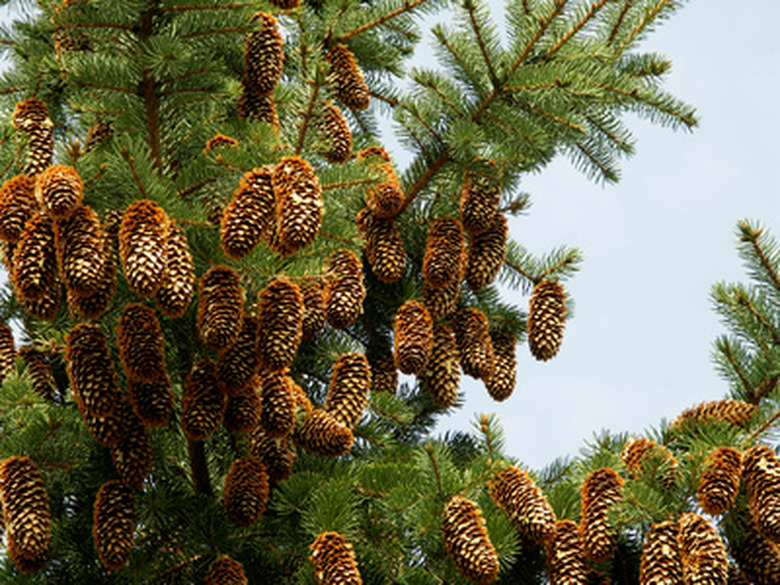Facts About The Norway Spruce
The Norway spruce (Picea abies) is a large introduced species from Europe that now grows in many parts of the United States and Canada in the wild. The naturalization of the Norway spruce occurred when the popular ornamental's seeds spread into forested areas. The Norway spruce has several uses. The tree can make a good Christmas tree, a large shade tree or a species that you will use for screens, hedges or other purposes on your property.
Identification
In it native land, the Norway spruce has the ability to grow well over 200 feet high, but in North America the tree rarely will exceed 130 feet, which still makes it an impressive sight. The trunk diameter can be around 3 feet on large specimens. The needles are a very dark shade of green, possessing four sides and being from a half inch to an inch in length. The branches can droop or grow horizontally to the ground and the mature cones are brown and as long as 6 inches. The bark on the older Norway spruces is a reddish color and its thin scales will flake off easily.
- The Norway spruce (Picea abies) is a large introduced species from Europe that now grows in many parts of the United States and Canada in the wild.
- The bark on the older Norway spruces is a reddish color and its thin scales will flake off easily.
Geography
The original range of the Norway spruce included Norway and other northern and central locations in Europe. The tree grows at high altitudes in these areas from 3,300 feet to 7,500 feet. The range extends from Scandinavian nations to the Balkan Mountains and into the Alps. In North America, the Norway spruce now grows in the Northeast, the southeastern portions of Canada, parts of the Rocky Mountains and in the Pacific Northwest.
Growing Conditions
The Norway spruce requires a cool moist climate to do well in but is an adaptable species and among the most versatile of the evergreens in this regard. The ideal setting for one is in acidic soil that has excellent drainage. Nevertheless, a Norway spruce will grow in clay, rocky soils, in dry conditions and in ground of any pH level. Pollution seems to have little effect on it and the Norway spruce will flourish in partial sunshine or full sun. The worst place to plant one is in a spot that is constantly wet, as this will rapidly cause the tree to perish.
- The original range of the Norway spruce included Norway and other northern and central locations in Europe.
- The Norway spruce requires a cool moist climate to do well in but is an adaptable species and among the most versatile of the evergreens in this regard.
Problems
The root system of a Norway spruce is typically shallow, lacking a deep taproot and making the tree susceptible to high winds blowing it over. The cones, the largest of any of the spruces, can be so abundant that they precipitate a litter problem beneath the tree when they finally do fall. The main insect pests of the Norway spruce are spider mites and certain types of aphids, which can feed upon and subsequently damage the needles.
Types
Several dwarf varieties of Norway spruce are available, all of which are slow growers, unlike the regular Norway spruce, which starts its life as a rapid-growth tree. The dwarf hybrids include Maxwellii and Gregoryana. Branches that will hang to the ground in the manner of a weeping willow highlight the Pendula and Reflexa cultivars. The shrub-like Nidiformis grows in such a way that the hybrid has the nickname of Bird's Nest Spruce, as the depression that occurs in the middle of the branches of this 3- to 6-foot tall plant remind one of a nest.
- The root system of a Norway spruce is typically shallow, lacking a deep taproot and making the tree susceptible to high winds blowing it over.
- The cones, the largest of any of the spruces, can be so abundant that they precipitate a litter problem beneath the tree when they finally do fall.
References
- Ohio Department of Natural Resources: Norway Spruce
- "National Audubon Society Field Guide to Trees"; Elbert L. Little; 2008
